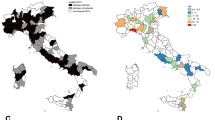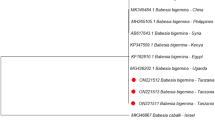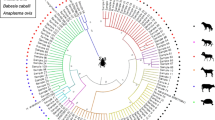Abstract
A molecular survey was undertaken in the Black Sea region of Turkey to determine the presence of Theileria and Babesia species of medical and veterinary importance. The ticks were removed from sheep and goats, pooled according to species and locations, and analyzed by PCR-based reverse line blot (RLB) and sequencing. A total of 2241 ixodid ticks belonging to 5 genus and 12 species were collected and divided into 310 pools. Infection rates were calculated as the maximum likelihood estimation (MLE) with 95 % confidence intervals (CI). Of the 310 pools tested, 46 (14.83 %) were found to be infected with Theileria or Babesia species, and the overall MLE of the infection rate was calculated as 2.27 % (CI 1.67–2.99). The MLE of the infection rates were calculated as 0.691 % (CI 0.171–1.78) in Haemaphysalis parva, 1.47 % (CI 0.081–6.37) in Rhipicephalus sanguineus, 1.84 % (CI 0.101–7.87) in Ixodes ricinus, 2.86 % (CI 1.68–4.48) in Rhipicephalus turanicus, 5.57 % (CI 0.941–16.3) in Hyalomma marginatum, and 6.2 % (CI 4.02–9.02) in Rhipicephalus bursa. Pathogens identified in ticks included Theileria ovis, Babesia ovis, Babesia bigemina, and Babesia microti. Most tick pools were infected with a single pathogen. However, five pools displayed mixed infections with T. ovis and B. ovis. This study provides the first molecular evidence for the presence of B. microti in ticks in Turkey.
Similar content being viewed by others
References
Aktas M (2014) A survey of ixodid tick species and molecular identification of tick-borne pathogens. Vet Parasitol 200(3–4):276–283
Aktas M, Dumanli N, Angin M (2004) Cattle infestation by Hyalomma ticks and prevalence of Theileria in Hyalomma species in the east of Turkey. Vet Parasitol 119:1–8
Aktas M, Altay K, Dumanli N (2006) PCR-based detection of Theileria ovis in Rhipicephalus bursa adult ticks. Vet Parasitol 140:259–263
Aktas M, Altay K, Dumanli N (2007) Determination of prevalence and risk factors for infection with Babesia ovis in small ruminants from Turkey by polymerase chain reaction. Parasitol Res 100:797–802
Aktas M, Altay K, Dumanli N, Kalkan A (2009) Molecular detection and identification of Ehrlichia and Anaplasma species in ixodid ticks. Parasitol Res 104(5):1243–1248
Aktas M, Vatansever Z, Altay K, Aydin MF, Dumanli N (2010) Molecular evidence for Anaplasma phagocytophilum in Ixodes ricinus from Turkey. Trans R Soc Trop Med Hyg 104:10–15
Aktas M, Altay K, Ozubek S, Dumanli N (2012) A survey of ixodid ticks feeding on cattle and prevalence of tick-borne pathogens in the Black Sea region of Turkey. Vet Parasitol 187(3–4):567–571
Aktas M, Ozübek S, Ipek DN (2013) Molecular investigations of Hepatozoon species in dogs and developmental stages of Rhipicephalus sanguineus. Parasitol Res 112:2381–2385
Altay K, Aktas M, Dumanli N (2008a) Detection of Babesia ovis by PCR in Rhipicephalus bursa collected from naturally infested sheep and goats. Res Vet Sci 85(1):116–119
Altay K, Aydin MF, Dumanli N, Aktas M (2008b) Molecular detection of Theileria and Babesia infections in cattle. Vet Parasitol 158:295–301
Altay K, Aktas M, Dumanli N, Aydin MF (2008c) Evaluation of a PCR and comparison with RLB for detection and differentiation of Theileria sp. MK and other Theileria and Babesia species of small ruminants. Parasitol Res 103:319–323
Altay K, Dumanli N, Aktas M (2012) A study on ovine tick-borne hemoprotozoan parasites (Theileria and Babesia) in the East Black Sea region of Turkey. Parasitol Res 111(1):149–153
Aydin MF, Aktas M, Dumanli N (2012) Tick infestations on sheep and goats in the Black Sea region. Kafkas Univ Vet Fak Derg 18(Suppl-A):A17–A22
Aydin MF, Aktas M, Dumanli N (2013) Molecular identification of Theileria and Babesia in sheep and goats in the Black Sea region in Turkey. Parasitol Res 112(8):2817–2824
Berggoetz M, Schmid M, Ston D, Wyss V, Chevillon C, Pretorius AM, Gern L (2014) Protozoan and bacterial pathogens in tick salivary glands in wild and domestic animal environments in South Africa. Ticks Tick Borne Dis 5(2):176–185
Çiçek H, Karatepe M, Çakır M, Eser M (2009) Blood parasites detected from Anatolian squirrel, Spermophilus xanthophrymnus (Rodentia: Sciuridae) in Nigde province, Turkey. Ankara Univ Vet Fak Derg 56:147–148
de La Fuente J, Estrada-Peña A, Venzal JM, Kocan KM, Sonenshine DE (2008) Overview: ticks as vectors of pathogens that cause disease in humans and animals. Front Biosci 13:6938–6946
de Vos AJ, Potgieter FT (1994) Bovine babesiosis. In: Coetzer JAW, Thomson GR, Tustin RC (eds) Infectious diseases of livestock, 2nd edn. Oxford University Press, Cape Town, pp 277–294
Ekici OD, Sevinc F, Isik N (2012) Instability of ovine babesiosis in an endemic area in Turkey. Vet Parasitol 188(3–4):372–375
Foppa IM, Krause PJ, Spielman A, Goethert H, Gern L, Brand B, Telford SR 3rd (2002) Entomologic and serologic evidence of zoonotic transmission of Babesia microti, Eastern Switzerland. Emerg Infect Dis 8(7):722–726
Friedhoff KT (1997) Tick-borne diseases of sheep and goats caused by Babesia, Theileria or Anaplasma spp. Parasitologia 39:99–109
Gachohi JM, Ngumi PN, Kitala PM, Skilton RA (2010) Estimating seroprevalence and variation to four tick-borne infections and determination of associated risk factors in cattle under traditional mixed farming system in Mbeere District, Kenya. Prev Vet Med 95(3–4):208–223
Georges K, Loria GR, Riili S, Greco A, Caracappa S, Jongejan F, Sparagano O (2001) Detection of haemoparasites in cattle by reverse line blot hybridisation with a note on the distribution of ticks in Sicily. Vet Parasitol 99(4):273–286
Gray J, von Stedingk LV, Gürtelschmid M, Granström M (2002) Transmission studies of Babesia microti in Ixodes ricinus ticks and gerbils. J Clin Microbiol 40(4):1259–1263
Gu W, Lampman R, Novak RJ (2003) Problems in estimating mosquito infection rates using MIR. J Med Entomol 40:595–596
Guan GQ, Ma ML, Moreau E, Liu JL, Lu BY, Bai Q (2009) A new ovine Babesia species transmitted by Hyalomma anatolicum anatolicum. Exp Parasitol 122:261–267
Heidarpour Bami M, Haddadzadeh HR, Kazemi B, Khazraiinia P, Bandehpour M, Aktas M (2009) Molecular identification of ovine Theileria species by a new PCR-RFLP method. Vet Parasitol 161(3–4):171–177
Hunfeld KP, Lambert A, Kampen H, Albert S, Epe C, Brade V, Tenter AM (2002) Seroprevalence of Babesia infections in humans exposed to ticks in midwestern Germany. J Clin Microbiol 40(7):2431–2436
Ica A, Vatansever Z, Yildirim A, Duzlu O, Inci A (2007) Detection of Theileria and Babesia species in ticks collected from cattle. Vet Parasitol 148:156–160
Iqbal F, Fatima M, Shahnawaz S, Naeem M, Shaikh R, Ali M, Shaikh A, Aktas M, Ali M (2011) A study on the determination of risk factors associated with babesiosis and prevalence of Babesia sp., by PCR amplification, in small ruminants from Southern Punjab (Pakistan). Parasite 18(3):229–234
Jongejan F, Uilenberg G (2004) The global importance of ticks. Parasitology 129(Suppl):3–14
Ozdarendeli A, Aydin K, Tonbak S, Aktas M, Altay K, Koksal I, Bolat Y, Dumanli N, Kalkan A (2008) Genetic analysis of the M segment of Crimean-Congo hemorrhagic fever virus strain in Turkey. Arch Virol 153(1):37–44
Ozdarendeli A, Canakoglu N, Berber E, Aydın K, Tonbak S, Ertek M, Buzgan T, Bolat Y, Aktas M, Kalkan A (2010) The complete genome analysis of Crimean-Congo hemorrhagic fever virus isolated in Turkey. Virus Res 147:288–293
Parviz S, Hooshmand E, Rahbari S, Nabian S (2008) Determination of Rhipicephalus spp. as vectors for Babesia ovis in Iran. Parasitol Res 101:1029–1033
Poyraz O, Güneş T (2010) Seroprevalence of Babesia microti in humans living in rural areas of the Sinop region. Türk Parazitol Derg 34(2):81–85
Ravindran R, Rao JR, Mishra AK (2006) Detection of Babesia bigemina DNA in ticks by DNA hybridization using a nonradioactive probe generated by arbitrary PCR. Vet Parasitol 141:181–185
Razmi G, Yaghfoori S (2013) Molecular surveillance of Theileria ovis, Theileria lestoquardi and Theileria annulata infection in sheep and ixodid ticks in Iran. Onderstepoort J Vet 80(1):635
Tavassoli M, Tabatabaei M, Mohammadi M, Esmaeilnejad B, Mohamadpour H (2013) PCR-based detection of Babesia spp. infection in collected ticks from cattle in west and north-west of Iran. J Arthropod Borne Dis 7(2):132–138
Tonbak S, Aktas M, Altay K, Azkur AK, Kalkan A, Bolat Y, Dumanli N, Ozdarendeli A (2006) Crimean-Congo hemorrhagic fever virus: genetic analysis and tick survey in Turkey. J Clin Microbiol 44(11):4120–4124
Uilenberg G (1995) International collaborative research: significance of tick-borne hemoparasitic diseases to world animal health. Vet Parasitol 57(1–3):19–41
Vannier E, Krause PJ (2012) Human babesiosis. N Engl J Med 366:2397–2407
Acknowledgments
This work was supported financially by grants (109 O 766) from the Scientific and Technical Research Council of Turkey (TUBITAK) and (45-M-12) Commission of Scientific Research Projects, Karamanoğlu Mehmetbey University. We thank all veterinarians, technicians, and also animal breeders in the region for their kind help during sample collection. We are also grateful to Weidong Gu (Health Statistician, PhD, Centers for Disease Control and Prevention, Atlanta, GA, USA) for MLE-IR program used for estimating infection rates of pooled samples.
Author information
Authors and Affiliations
Corresponding author
Additional information
Nucleotide sequence data reported in this paper are available in GenBank, EMBL 21, and DDBJ databases under accession numbers from KF737169 to KF737171.
Rights and permissions
About this article
Cite this article
Aydin, M.F., Aktas, M. & Dumanli, N. Molecular identification of Theileria and Babesia in ticks collected from sheep and goats in the Black Sea region of Turkey. Parasitol Res 114, 65–69 (2015). https://doi.org/10.1007/s00436-014-4160-x
Received:
Accepted:
Published:
Issue Date:
DOI: https://doi.org/10.1007/s00436-014-4160-x




